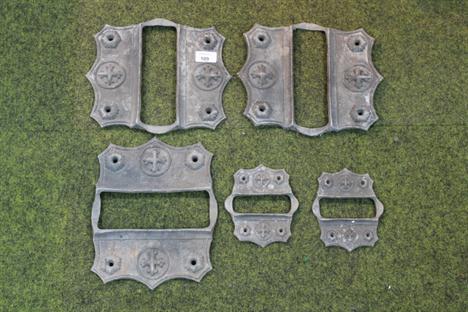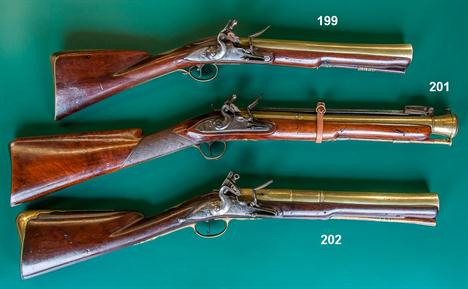A 19th Century East India Company Percussion Cap Service Pistol, with 20.5cm steel barrel, the lock plate bearing traces of EIC lion logo, the full walnut stock stamped on the left side EIC 74, with brass ramrod pipe, trigger guard and butt cap with steel lanyard ring and swivel steel ramrod
We found 43904 price guide item(s) matching your search
There are 43904 lots that match your search criteria. Subscribe now to get instant access to the full price guide service.
Click here to subscribe- List
- Grid
-
43904 item(s)/page
A REGULATION PERCUSSION SEA SERVICE PISTOL dated 1847, 5 3/4" barrel, overall 11 1/2", barrel with government proofs, the lock plate stamped Crowned GR & Tower 1847, swivel ramrod with belt hook to left side, brass butt cap, ramrod pipe and trigger guard stamped 187, walnut full stock with B.O. stamp, action faulty, two screws missing from lock, woodwork damaged particularly to left side, working order
A REGULATION PERCUSSION SEA SERVICE PISTOL dated 1847, 5 3/4" barrel, overall 11 1/2", barrel with government proofs, the lock plate stamped Crowned GR & Tower 1847, swivel ramrod with belt hook to left side, brass butt cap, ramrod pipe and trigger guard, walnut full stock with iron butt cap, in good overall condition, stock damage to left side, working order
A flintlock brass barrelled blunderbuss by Robert Harvey late 18th century, the 35.5cm. brass three stage barrel belled at the muzzle and octagonal at the breech with stiff leaf engraving, stamped with London and maker`s proof marks, signed border and foliate engraved rounded steel lock plate, figured mahogany full stock with border engraved brass mounts including trigger guard with vase finials, brass ramrod pipe with ramrod.
13x Britains Elizabeth II Golden Jubilee sets: Band of the Lifeguards Sets 1-3 (40300, 40301, 40302); Royal Scots Fusiliers Band Sets 1-3 (40325, 40326, 40327); Band of the 7th Hussars Sets 1-3 (40264, 40265, 40294); Gordon Highlanders Pipe & Drum Band Sets 1-4 (40329, 40330, 40331, 40332). M and boxed. (13).
A Japanese Walrus Ivory Figure Group, late Meiji period (1868-1912), as two gentlemen by a bench, one seated holding a fan, the other in conversation while holding a pipe and tobacco pouch, an open scroll and pipe case close by, 11.5cm high, 13.8cm long, upon a carved and stained softwood shaped stand See illustration
Interesting antique small oval horn snuff box incised with primitive figures in landscapes, a verse and dated 1594, with iron hinged lid, 2" wide; also a circular papier mache castle top snuff box inscribed `May the electors of Lewes ever be at liberty to take whatever snuff they please`, 3.5" diameter and a cased Meerschaum pipe (3)
A Zeppelin relic from Potters Bar 1916. Comprising a small cut section of Zeppelin frame mounted on a small wooden plinth. The piece is 9cm x10cm. Together with a four way brass and alloy gas pipe junction mounted on a black wooden square base. With engraved silver plate inscribed `Zeppelin L.85 Salonika May 5th 1916. The pipe is 8cm x 8cm. GC
A unique combination group of four to Henry James Leech, Foreman Engineer of the Royal Airship Works Cardington who was awarded the Albert Medal for his heroic attempt to rescue comrades from the R101 crash comprising: The Albert Medal 2nd Class in Bronze for Land service, reverse engraved ‘Presented by His Majesty to Henry James Leech A.F.M. for Gallantry in saving life when the Airship R101 was wrecked near Beauvais (France) on the 5th October 1930’; Air Force Medal, George V issue (212339 Sergt Mech Leech, H.J. RAF), British War and Victory medals (212339 Sgt H J Leech, RAF), GVF, mounted as worn court style. The Albert Medal case is also present. Note: Albert Medal London Gazette 31 October 1930 His Majesty the King has been graciously pleased to award the Albert Medal to Mr Henry James Leech, A.F.M., Foreman Engineer of the Engine Test House, Royal Airship Works, Cardington, in recognition of his gallantry when the Airship R101 was wrecked near Beauvais on the 5 October, 1930. Despite terrifying experiences in extricating himself from the blazing wreckage, Mr Leech immediately at grave risk re-entered the burning mass and succeeded in disentangling a companion from the network of red-hot girders and hauled him into safety, himself sustaining burns in the process.’ The colleague rescued was wireless operator Arthur Disley who himself was awarded the British Empire Medal and who had telephoned the Air Ministry to break the news of the disaster. At the time of the crash Leech had been relaxing on his own in the smoking room and had been concerned with the pitching and rolling of the vessel. As Foreman Engineer at the Royal Airship Works he had been involved with the series of engine tests and quickly realised the extent of the situation. When R101 crashed the smoking room was suddenly plunged into darkness. As he tried to get out he found the door had been blocked by damage, consequently Leech had to break through an asbestos bulkhead to get to safety, a feat made more difficult as the lightweight furniture used in keeping the weight of the airship down smashed on impact with the walls. Reaching a companionway with the inferno all about he managed to reach a gap in R101`s side and jumped to safety, his fall being broken by a tree. As he fell through the saturated branches he was drenched in rainwater and later described it as ‘the best drink of my life’. Despite being badly burned, Leech joined two other survivors, Arthur Bell and Joe Binks, and tried to rescue other crew members. At Beauvais on the Tuesday morning the 3 survivors (of 6) were well enough to attend the sombre parade. (See plate 18). Shortly before 11.00 am a poignant 101 gun salute to the fallen filled the air, followed by the British and French National anthems then the repatriation process began. 23 army wagons, each carrying 2 coffins, made for the station, the train taking them to Boulogne to transfer to 2 destroyers HMS Tempest and HMS Tribune. Air Force Medal London Gazette 8th February 1919. This was awarded when Sergeant Mechanic Leech was Second Engineer with the crew bringing the Airship SR1 from Italy. The British Government had purchased a Semi Rigid airship (SR1) from the Italians. Leech was part of the 9 man crew who brought the vessel back to England leaving Rome on the 28th October and arriving back at Kingsnorth Airship Station on 31 October. During this trip an exhaust pipe became detached and fell to close proximity of the fuel tanks. Captain T.B. Williams (2nd Officer) and Leech climbed up a ladder and jettisoned the burning mass overboard thus preventing catastrophic consequences. Henry James “Harry” Leech was born in Dudley in 1890 and from 1906 served an apprenticeship at the B.S.A. Company working on motor car manufacturing. He joined the R.N.A.S (Airship Section) in 1916 where he served until demobilized in 1919. In 1920 he answered an advert in a local newspaper recruiting experienced men for the development of airships at Pulham in Norfolk and was put in charge of the Engine shops. In 1924 he transferred to the Royal Airship Works, Cardington. Following the demise of the Airship programme Leech went to America to work as an engineer with Kaye Don (who set various land speed records) and also worked as an engineer with Sir Malcolm Campbell at Daytona in 1932. In later years he moved to Southampton and worked on developing equipment used to combat Cancer, illustrated on Plate 18.
John Robertson Reid - Coastal View with an Old Sea Salt seated by a Basket of Fish and smoking a Clay Pipe, other Fishermen preparing their Boats beyond, early 20th Century oil on canvas, signed and dated `05, approx 34cm x 51cm, within a gilt composition frame with foliate corner crestings and stiff leaf and berry moulding.
-
43904 item(s)/page






















































